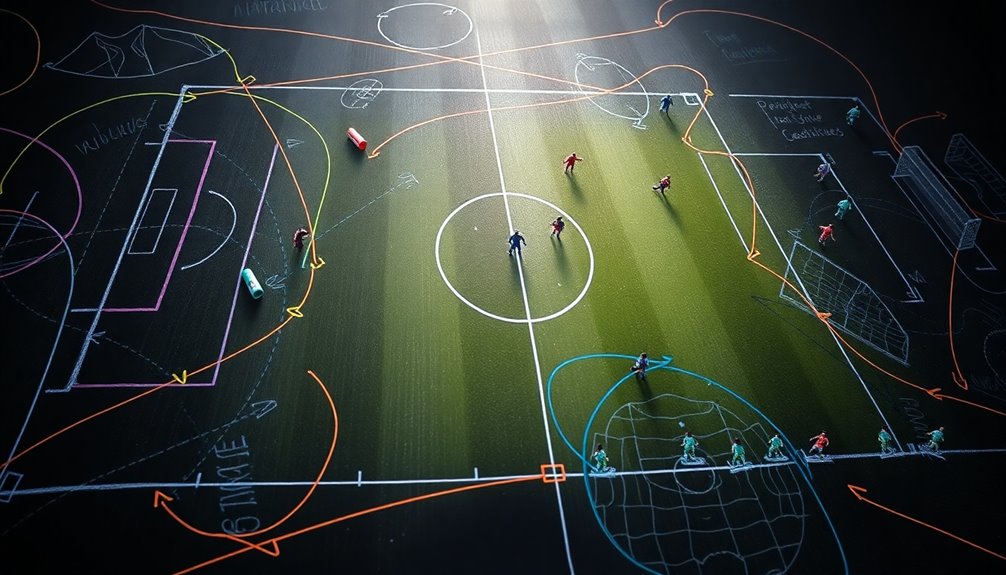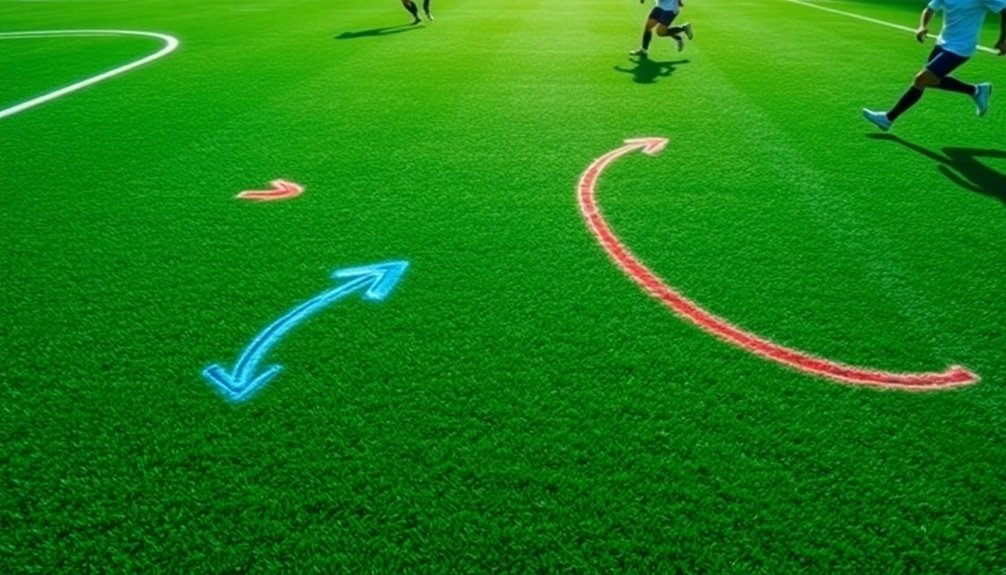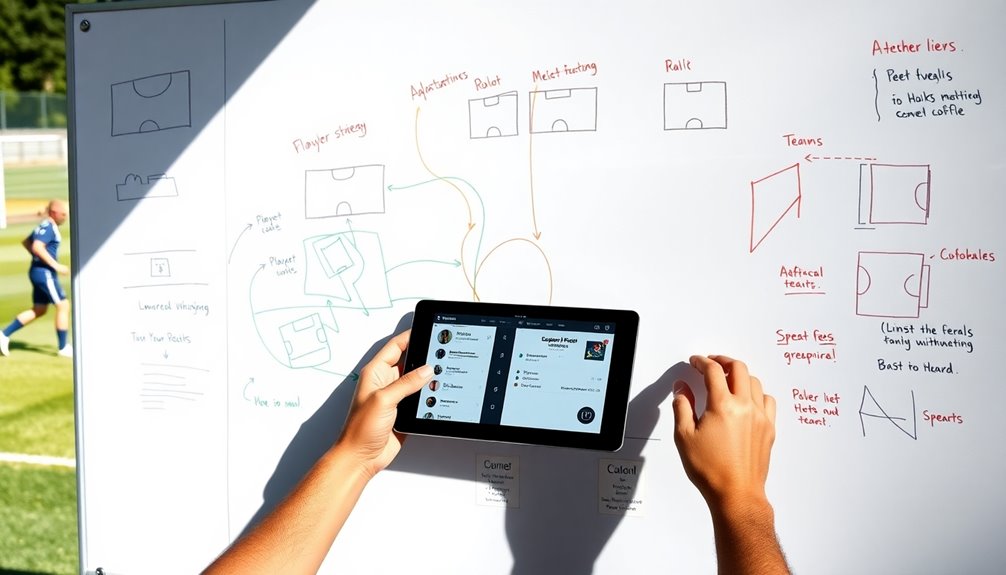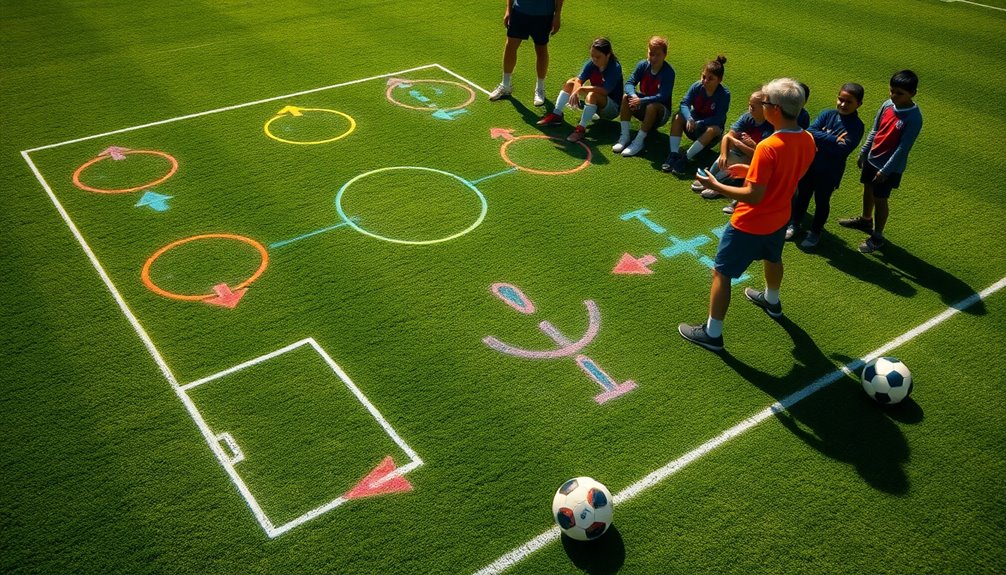
Creative Tips for Drawing Soccer Plays and Strategies
January 31, 2025To draw creative soccer plays and strategies, start by mastering formations like 4-4-2 and 4-3-3, which help your team understand game dynamics. Use platforms like SoccerDrive.com for easy diagram creation, where you can incorporate color coding to clarify player roles. Adding movement arrows enhances visualization, indicating how players should move during a play. Keep communication concise and open, using simulations to engage your team. Avoid common mistakes like overcomplicating formations and neglecting player labels. Embrace a mindset of continuous improvement to develop effective strategies that adapt to any opponent you face next!
Importance of Creative Play Design
Creative play design is essential in soccer because it enhances your team's tactical awareness and adaptability. When you incorporate unique formations and plays, your players can better understand the dynamics of the game. This understanding allows them to respond to opponents more effectively and creates unpredictable patterns that can exploit defensive weaknesses. Additionally, leveraging various formations can provide your team with strategic advantages against different opponents.
Utilizing small-sided games in practice is a fantastic way to encourage experimentation with new plays and strategies. These smaller formats foster a fun and engaging training environment where players feel free to express their creativity. As they try out different approaches, they'll develop a deeper comprehension of tactical movements and their roles on the field, including the importance of effective communication among teammates.
Empowering your players to contribute to the play design process not only builds their ownership but also inspires innovative solutions during actual game scenarios. By doing so, you cultivate a team that's not just reactive but proactive, ready to adapt and seize opportunities as they arise.
Additionally, understanding the specific roles of players on the field can greatly enhance the effectiveness of your creative strategies. In this way, creative play design becomes a cornerstone of your training, enhancing both individual and team performance on the pitch.
Essential Drawing Tools and Resources
When you're planning your soccer strategies, having the right drawing tools can make all the difference.
Online platforms like SoccerDrive.com give you the flexibility to create and share your plays easily. Additionally, incorporating various formations into your drawings can enhance your team's effectiveness on the field. Practicing passing accuracy through drills can also help you develop strategies that maximize your team's performance.
Plus, mastering essential drawing techniques helps you visualize formations and tactics effectively. Additionally, understanding the offside rule can enhance your strategic planning by ensuring your plays are both effective and compliant with game regulations.
Online Drawing Platforms
Coaches can greatly enhance their game strategy with online drawing platforms that offer essential tools for creating tactical diagrams.
These platforms, like SoccerDrive.com, empower you to visualize your ideas, making it easier to convey complex soccer drills and practice plans to your team.
Here are four key advantages of using online drawing platforms:
- User-Friendly Tools: Most platforms provide intuitive interfaces, allowing you to create diagrams quickly without needing advanced graphic skills.
- Accessibility: You can access your drawings from any device, ensuring you can review and share your strategies anywhere, anytime.
- Collaboration: Save and share activities, drills, and practice plans with your coaching staff, fostering teamwork and alignment in your training approach.
- Pre-Made Templates: Many resources offer soccer-specific icons and templates, enabling you to create professional diagrams efficiently.
Essential Drawing Techniques
Using online drawing platforms is just the beginning; mastering effective drawing techniques takes your tactical planning to the next level. Start by utilizing tools like those on SoccerDrive.com to create and save tactical diagrams. These platforms allow you to easily access your work from any device, making adjustments on the go simple and efficient.
Incorporate basic shapes and symbols to represent players, formations, and movements. This clarity guarantees your diagrams communicate coaching points clearly.
Color coding is another smart strategy; use different colors for teams and roles to enhance visual understanding and differentiate between player positions and strategies.
Don't forget to explore resources that offer templates for common formations and drills. This will enable quick adaptations during your practice planning.
Engaging with online coaching communities can also provide valuable feedback on your drawings. Sharing your tactical diagrams with others fosters collaboration and sparks new creative ideas.
Understanding Soccer Formations

Soccer formations play an essential role in defining a team's strategy and overall performance on the field. Understanding how different formations impact player roles can enhance your tactical awareness. Here are some common formations you might consider:
- 4-4-2: This classic setup emphasizes strong partnerships among players, particularly between strikers and midfielders.
- 4-3-3: Known for its fluidity, this formation allows for greater attacking options and better midfield control.
- 2-1-2: This formation strikes a balance between defense and attack, ensuring players can support both ends effectively, making it similar to the 2-3-1 formation that teaches teamwork and strategic positioning.
- 2-2-1: By positioning midfielders closer to the goal, this setup increases shooting opportunities.
As you draw these formations, remember that tactical flexibility is essential. Players need to adapt based on fatigue, the strengths of opponents, and the dynamics of the game. Additionally, understanding the roles of wing-backs in maintaining defensive stability while supporting attacks is key to enhancing team performance.
Midfielders often play dual roles, supporting both attack and defense while maintaining shape to cover gaps. Incorporating pressing strategies, like high pressing, can also be critical for regaining possession quickly.
Understanding these aspects will help you depict soccer plays more accurately in your drawings.
Utilizing Color Coding Effectively
When you're creating your soccer play diagrams, choose distinct color palettes that make roles clear at a glance.
Assign specific colors to each player role—like blue for defenders and red for midfielders—so everyone understands their responsibilities. This approach not only aids in visualization but also enhances team communication during practices and games. Additionally, ensuring that your team is familiar with team culture can further improve understanding of each player's role in various strategies. Incorporating essential techniques for precision in your plays can also lead to more effective execution on the field. Effective defensive stance can ensure that defenders are ready to react quickly to any offensive plays.
Choose Distinct Color Palettes
A well-chosen color palette can greatly enhance the effectiveness of soccer drawings, making strategies easier to grasp. When you utilize distinct colors, you help players understand their roles and movements on the field more clearly.
Here are some tips to evaluate when selecting your color palette:
- Differentiate Teams: Use contrasting colors to represent opposing teams, ensuring players can easily identify their teammates and opponents.
- Highlight Roles: Assign specific colors for offensive and defensive players. This way, critical movements related to the ball are more visible during tactical discussions.
- Consistent Scheme: Maintain a uniform color scheme across all your drawings. Consistency helps players need to recall strategies quickly during practices and matches.
- Leverage Tools: Utilize software or online platforms that allow customizable color options. This can make your drawings more visually appealing and engaging for both players and coaching staff.
Assign Roles With Colors
Using color coding to assign roles not only simplifies the understanding of player responsibilities but also enhances communication on the field. When you designate specific colors—like red for defenders, blue for midfielders, and yellow for forwards—it creates visual clarity. This way, you and your coaching staff can quickly identify tactical positions during practice or game analysis.
Color-coded diagrams also make it easier to convey complex strategies. When you explain a play, players can instantly recognize their movements and responsibilities based on their assigned colors. This is especially useful for quick adjustments during games, allowing players to execute one touch passes without hesitation.
Incorporating color coding into your training materials promotes better retention of tactical concepts, helping players grasp team dynamics. When you consistently use the same color scheme across all resources, it fosters familiarity, reinforcing what they've learned.
Ultimately, assigning roles with colors not only streamlines communication but also improves overall team performance on the field. So, whether you're drawing plays or discussing strategies, make color coding a key part of your approach to soccer coaching.
Incorporating Movement Arrows

How can movement arrows enhance your understanding of soccer strategies? By clearly illustrating player movements and positioning, movement arrows help you grasp tactical strategies more effectively.
When you incorporate movement arrows into your drawings, consider the following tips:
- Use Color-Coding: Different colors can represent various types of movements, such as offensive runs (green), defensive shifts (red), or changes (blue). This enhances visual understanding and makes it easier to distinguish between strategies. Additionally, understanding fit preferences can aid in selecting the best players for specific roles in your strategies. Incorporating offensive plays can further enrich the tactical application of color-coded arrows.
- Draw Directionally: Always draw arrows in the direction of movement to indicate both the trajectory and intended destination. This practice aids in comprehending game dynamics and the flow of play.
- Incorporate Dashed Lines: Use dashed lines to depict potential pathways or alternate movements. This encourages players to think creatively, considering various options during gameplay.
- Practice Regularly: Regularly use movement arrows in your drawings to help players visualize formations and strategies. This practice ultimately improves their on-field decision-making and execution.
- Incorporating movement arrows can also support the development of tactical awareness, allowing players to make more informed decisions during gameplay.
Collaborating With Teammates
When you're on the field, effective communication is key to executing plays successfully.
By building trust among your teammates, you'll create a supportive environment where everyone feels comfortable sharing ideas and strategies.
This collaboration not only enhances your gameplay but also strengthens your team's overall performance. Additionally, clear communication with teammates helps coordinate defensive assignments and offensive movements, ensuring everyone is on the same page.
Effective Communication Techniques
Effective communication is essential for a soccer team's success, as it fosters collaboration and sharpens on-field strategies. To enhance your team's effectiveness, consider these effective communication techniques:
- Establish Clear Signals: Create specific codes for plays and formations. This guarantees everyone knows the strategy being executed during the game.
- Use Concise Language: In fast-paced situations, clear and direct communication can prevent confusion and enhance decision-making.
- Encourage Open Dialogue: During training, promote an environment where players can share their thoughts and suggestions. This collaboration strengthens team dynamics.
- Utilize Non-Verbal Cues: Non-verbal communication, like gestures and eye contact, conveys intentions without disrupting the flow of play, especially in noisy environments.
Building Trust Among Players
Fostering trust among players is essential for creating a cohesive soccer team that can execute strategies seamlessly on the field. When players trust each other, communication improves greatly, allowing for quick decisions and effective execution of complex plays.
To build this trust, encourage open dialogue during practice sessions. Create a space where everyone feels comfortable sharing ideas and concerns, fostering a collaborative environment.
Engaging in team-building activities outside of soccer can further strengthen those interpersonal relationships. Activities that encourage teamwork help players bond, which translates to better synergy during games.
Additionally, regularly rotating players through different positions during training can enhance understanding and appreciation of each other's roles, cementing that trust.
Finally, providing constructive feedback in a supportive manner reinforces trust. When players feel valued and understood, they're more likely to work together harmoniously on the pitch.
Visualizing Player Dynamics

In soccer, visualizing player dynamics is essential for understanding how players move and interact on the field during various phases of play. By illustrating movement patterns, you can better grasp their roles in different formations—be it attacking, defending, or shifting.
Here are some effective strategies to enhance your visualizations:
- Use Arrows: Draw arrows to indicate player runs and passing lanes. This helps everyone understand spatial relationships and tactical approaches.
- Color-Code Symbols: Assign specific colors to represent various player positions, like defenders, midfielders, and forwards. This makes it easier to communicate formations during training.
- Label Tactical Concepts: Incorporate labels such as "pressing" or "counter-attack" in your diagrams. This links visual representations with specific strategies and desired outcomes.
- Update Regularly: Keep your visualizations current and share them with team members. This fosters a collective understanding of gameplay dynamics, improving communication and tactical awareness on the field.
Techniques for Clear Communication
Utilizing clear communication techniques is vital for successful soccer coaching. As a youth coach, you need to convey complex strategies and formations in a way that players can easily understand. Start by using clear terminology and visual aids, like diagrams and drawings, to illustrate your points during training sessions.
Regular feedback sessions are important. These meetings foster open dialogue between you and your players, allowing clarification of roles and expectations. Encourage players to express their thoughts and ask questions about tactics; this engagement can greatly enhance their understanding and retention of strategic concepts.
Incorporating online platforms can also improve communication among your coaching staff. Share training resources and collaborate on planning to keep everyone informed and aligned. Establishing a consistent communication protocol, with regular updates and check-ins, guarantees that all team members are on the same page.
Ultimately, your goal is to create a culture of open communication. This approach not only helps players grasp the strategies effectively but also builds trust within the team, making your coaching more impactful.
Clear communication is the backbone of effective soccer coaching, especially for youth teams.
Adapting Strategies for Different Teams

When preparing for a match, adapting your strategies to fit the unique characteristics of your team and the opponent can make all the difference. By understanding both your team's strengths and the weaknesses of the opposing side, you can create a game plan that maximizes your potential while targeting the opposition goal effectively.
Here are some key steps to deliberate:
- Assess Player Attributes: Evaluate your players' speed, technical ability, and tactical understanding to craft a strategy that fits their skills.
- Choose the Right Formation: Utilize formations like 4-4-2 or tiki-taka based on the opponent's style, allowing you to exploit their vulnerabilities while leveraging your strengths.
- Incorporate Feedback: Regularly gather player feedback and analyze performance data to adjust your strategies, addressing areas that need improvement.
- Conduct Video Analysis: Study the opposing team's gameplay to identify patterns and tendencies, enabling you to develop effective counter-strategies.
Common Mistakes to Avoid
Clear communication is essential when drawing soccer plays and strategies, yet many coaches make common mistakes that can hinder understanding. One major error is failing to clearly label players and positions. When your drawings lack proper identification, confusion reigns during discussions.
Additionally, overcomplicating formations or plays with excessive detail overwhelms viewers; remember, simplicity and clarity are key to effective communication.
Neglecting to incorporate directional arrows is another pitfall. Without these indicators, movement patterns become ambiguous, making it tough for players to grasp the intended flow of the play.
It's equally important not to ignore the context of the playing area. If your drawings don't reflect actual dimensions and boundaries, they may lead to unrealistic representations that don't translate well to gameplay.
Lastly, don't skip the essential step of reviewing and revising your drawings for accuracy. Overlooking this can perpetuate misunderstandings and miscommunications during coaching sessions.
Engaging Players With Diagrams

Frequently engaging players with diagrams can greatly enhance their understanding of plays and strategies. Visual representations clarify positioning and movement, allowing players to see how to create space and support the player with the ball.
Here are some effective ways to use diagrams in your coaching:
- Simplify Complex Strategies: Break down intricate plays into easy-to-follow visuals. This helps players grasp tactical concepts quickly.
- Use Color-Coding: Differentiate player roles and responsibilities by incorporating color-coded elements. This fosters better communication and execution on the field.
- Interactive Sessions: Involve players in discussions about the diagrams during team meetings. Encourage feedback to help them take ownership of their tactical development.
- Regular Updates: Keep your diagrams fresh by regularly updating and sharing them throughout the season. This keeps players engaged with evolving strategies and formations.
Utilizing these methods not only enhances understanding but also promotes teamwork and strategic thinking.
Continuous Learning and Improvement
Coaches need to embrace continuous learning and improvement to stay effective in their roles. By exploring various training methods, such as attending workshops, reading coaching books, and listening to relevant podcasts, you can gain fresh insights and strategies that keep your coaching approach dynamic.
It's crucial to adapt your training sessions based on player feedback. This guarantees you're meeting their needs and preferences, enhancing their overall experience.
Engaging in ongoing education is important. Obtaining coaching certifications or attending coaching clinics not only develops your techniques but also keeps you updated on the best practices in youth soccer.
Additionally, sharing successful training strategies and resources with peers fosters a collaborative coaching community, enhancing everyone's effectiveness.
Regularly updating your training resources guarantees you have access to the latest tools and techniques. By troubleshooting any technical issues promptly, you maintain engagement in your coaching delivery.
Conclusion
Incorporating creative play design can considerably enhance your team's performance. Did you know that teams using visual aids to strategize see a 20% increase in understanding among players? By utilizing effective drawing tools, color coding, and movement arrows, you can make complex strategies more accessible. Remember, engaging your players with clear diagrams not only boosts their comprehension but also fosters teamwork. Keep refining your methods, and watch your strategies come to life on the field!


